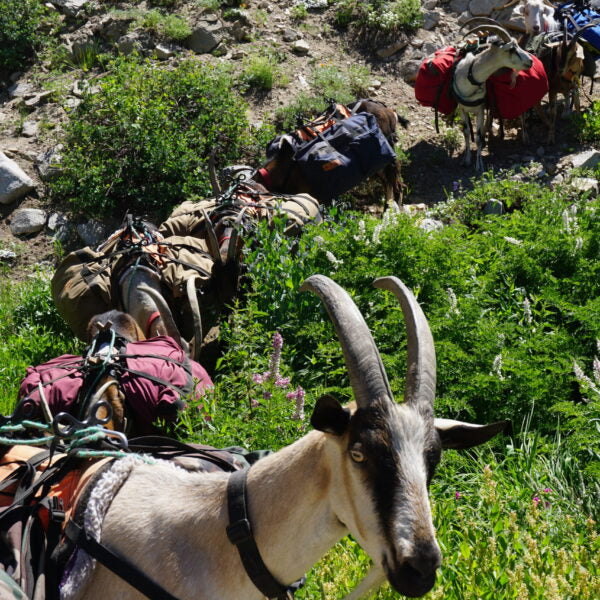My Store

What Breed Makes the Best Pack Goat
What is the best pack goat breed?
I get asked all the time what breed makes the best pack goat. I also get asked all the time what breed of goats I have. Generally, people are asking because they want to know what breed they should be looking for as they begin to build their string. In this article I am going to break down my favorite breeds and hybrids. Also, I'll speak to what I look for in each, and why I like to use them. Then, I'll share with you what I've found doesn't work well and why. Lastly, I will go into detail on breeders and genetics and why I believe that is more important than breed alone.
Please note: I've written this article based on personal experience and preferences based on that experience. Many people have packed successfully with many different goats. If you're interested in raising goats or just getting your first kids, check out our course on everything you need to know on how to raise a goat in it's first year, How to Raise a Baby Goat Course.
Breeders
Let's first dive into generalities of what I look for in a pack goat. First, I must say… IT'S WAY MORE ABOUT THE BREEDER AND PROVEN GENETICS THAN IT IS THE BREED ALONE!!! For info on where to buy goats, check out our Goats for Sale page. Now, bear in mind that basing your decision off of looking at a buck, doe, or baby is PhD level knowledge. I believe that very few of us have enough skill to do this well. It's taken me years of experience, and sometimes I still feel like I'm not sure. To the untrained eye it's all guess work to know what kind of wether a kid will grow to be. Additionally, to determine this from the look of its mother and father is total guesswork for a beginner.
I look for a leggy goat whose body-to-leg ratio has more leg. When a goat has a deep body, he is carrying inefficient weight. I look for a bit of width in a nice flat back; nice straight legs with his rear hooves pointing slightly outward. The rear hooves pointing slightly outward is to avoid a "rolling ankle" that will show up if it they are too straight. I'm also not a fan of really long goats which is what the dairy industry is currently breeding for. You want a "short wheel base."
The Best Genetics
Proven genetics produce proven wethers of adequate size and with good temperament. Please don't guess and try to save yourself a few dollars. It will cost you a crazy amount of money over time. You have to remember in just food, vet care, minerals, and time; you will have 1000's of dollars invested in your string. The cheapest of cheap baby goats is $100. In comparison to the $500 you will spend on a proven packer, the $400 in savings will cost you three times that, if after 4 years, you have a little goat that can't pack. The number one mistake new people make is buying their neighbor’s baby goat and hoping it will be a good packer.
Alpines
Now that we have that out of the way, let's talk about breeds. This information is based off of past experience and what I like most. If I only have one word to answer what breed makes the best pack goat, it's Alpine. My favorite single breed of goat is an Alpine. They have the most heart, athleticism, confirmation, and size, all characteristics I look for. They are consistently the "heart" of my string and the other breeds follow their lead. I have Alpine genetic lines that produce wethers that are 220 - 250 lbs. and can be as much as 40 inches at the shoulder. That is the ultimate pack goat for me.
Attitude, heart, desire... That is the "X" factor that Alpines bring as their gift. It's also their curse. Alpines have a tendency, as a breed to be brutal to other goats. They will most often be your "turd" to the others in your string. It's their "flaw" that comes with all their other good. As a side note, while we are talking Alpines, many of this breed can be very "A" framed, and not have quite the width I like. You want a goat with something for the saddle to "sit" on and have a wide and stable stance. Alpines can be too slender sometimes. I like Alpines that carry width in their genetics. Here is a good video showing my goats in the back country.
Oberhalsi
My second favorite goat is the Oberhasli. They can have very similar traits to Alpines, but come with a sweeter disposition toward other goats. They seem to be super athletic, maybe even more than Alpines. However, I have found them to have less heart than Alpines. I love having them in my string, and always will, as they are a nice balancing energy. They are great "middle of the string" goats. My favorite hybrid is Ober/Alpine cross, by the way, and they make for a beautiful goat as well. The down side of Obers is often size. Most Obers will finish near 150 lbs. which is small for a packer. I only know of a few lines in the country that get over 200. You can find more about those HERE.
Lamancha
Lamanchas are quickly becoming a breed I'm getting more interested in. They have the bone structure and are a "close to feral" goat. Their parasite resistance and benefits in that aspect are really good. Lamanchas can be huge and tall. I love their attitude and loving nature. I have less experience with them in my string only because I have always thought their ears are weird. It's funny, but I have just found them unattractive, especially without horns. Now that I have one (who is horned), I wonder what the hell I was thinking, I love him.
Now, please know my personal level of experience with this breed is still low by comparison. I have been paying attention to it for a long time now, and now am impressed with this breed for a packer. They are very hard working and sweet. I also like them crossed with Alpines and Obers, then they get little "elf ears”. Then they're cute and at least have some head gear. This is another breed that can sometimes lack the width, so I like so be sure to be mindful of the confirmation flaws that I see show up in each breed.
Saanen
Saanens are a breed we have often crossed with other breeds for size, but as a hunter I'm not a fan of the white goat. I have one white goat in my string now; Noah is an amazing Saanen/Boer cross often called a “Sabor”. From a hunter’s point of view, a white goat sticks out like a sore thumb, so I'm not a fan of the color. I am a fan of the size and disposition, though. They are a good goat for both of those things if the color works for you...
They are a nice packing breed, but be sure to get a "slim" genetic line of Saanen as I have seen some "round" ones. Round goats carry extra inefficient bulk and are too wide in my opinion. One thing to note about this breed is that they are not very heat resistant. If you are packing in high temperatures this breed might not be for you.
Nubian
Nubians are a breed I have packed with and cross bred a fair amount. I can say with confidence that I would not invest in a pure-bred Nubian as a packer for three reasons. Those reasons are clumsiness, lack of heart, and their tendency to be super vocal and annoying, noise-wise. Noise sounds like a menial issue, but for those of us that have goats in suburban areas especially, or are hunters like myself, it can be a big issue.
That said, I would cross with other breeds and be willing to have up to 25% Nubian in an Alpine cross or something like that. Nubians are very sweet and they can be huge, and tall! Mixing them with other breeds has been awesome, but anything over 25% scares me as I have seen that produce a vocal goat. That is a bottom line "can't have" in my pasture and my string. This is also a very submissive breed that will gladly pull up the rear, which every string needs.
Toggenburg
Last of the dairy breeds that I'll speak of is the Toggenburg. I have had bad results so far with this breed and am scared to invest energy into them. They are on the small side as a breed and I have found their temperaments to be consistently "weird" and "stand-offish”. I do know of a few people who have had luck with them and would swear by the goats they have so there is something there.
Overall, I’m trying to give advice that, in my opinion, will produce a wide range of success, and for that, I would avoid this breed. They also have a tendency to be very hairy which makes them hot in the warm months, and their horn flare can pose a problem as well. I say this knowing some Togg lovers will send me a nasty note or two, but that's how I feel about that breed in general. Some have had great luck with them; I'm personally just not a fan.
Meat Breeds
Now let's talk about the meat breeds, Boer and Kiko. Both of these breeds by themselves (pure breeds) I would skip as packers for several reasons. One is the horizontal horn configuration which makes them dangerous to other goats. This is particularly true in the trailer. Also, it's harder to work with when packing; a slight head turn and I have a horn in the gut or a horn in the thigh if they pass me. Both have a tendency to be shorter, and having a tall packer is hugely advantageous. Having a short one is can be very debilitating; they do not have the ability to keep up, cross obstructions, and keep the panniers out of the rocks and snags.
Lastly, and most importantly, these two goat breeds are bred to put weight on. After their fourth year you now have a goat that constantly has his head in the hay feeder. Fat goats suffer on the trail, and it's hard to help them lose fat after an off season. The trouble is they just put on fat quickly. Fat, muscle-bound goats also have a hard time staying cool and maintaining high levels of endurance. Imagine a lineman versus a wide receiver in a marathon; the wide receiver wins every time.
One thing I do love about these breeds is their easy-going nature because they have submissive tendencies. This makes them nice at the back of the string and I have also found them both to have awesome feet, which is great. I like both of these crossed with Alpines, but only in about a 25% ratio or less. I'm not a fan of the 50% crosses as they still struggle to stay thin, and they are too wide and have too much muscle for me.
My Favorite Hybrids
My favorite hybrids are Alpine/Ober followed by Alpine/Sabor (Saanen/Boer). It "tames the beast”, of Alpines, but keeps the heart and adds some nice width when you cross with the Sabor. Sabor/Ober and lastly, Alpine/Lamancha are my other favorites. Bred correctly the Sabor/Alpine can be an amazing goat with lots of width, a sweet disposition, the heart of a lion and it can be huge and tall. Your Ober/Alpines are one of the most beautiful goats, and the Alpine/Lamancha can be a sweet athlete with those little elf ears.
When you cross goat breeds, you get what is called "hybrid vigor" which helps with many things and diversifies their genetics helping them to get closer to the mountain goat they originally were. By the way, one of the best ways to ensure you get some color out of your Sabor is to cross it with an Ober. They will have a tendency to have color more often than crossed with an Alpine.
My Conclusion to What Breed Makes the Best Pack Goat:
Some are going to hate this article as they are partial to breeds I am not, others may agree. My aim is to speak to generalities rather than "rules." Every breed has an awesome packer within, but some breeds will have a higher level or potential of success and that is what I'm speaking to here. If you would like to know where to go to find proven packer genetics click here. Lastly, there are still years of work to do to truly know the facts about breeding as this is still a new sport. Ultimately, the breeding is just beginning to be formalized, and breed standards are still in the works.
I hope you find this helpful, Marc.





